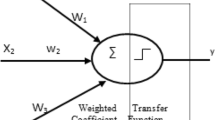Abstract
A neural-network-based methodology is proposed for predicting the surface roughness in a turning process by taking the acceleration of the radial vibration of the tool holder as feedback. Upper, most likely and lower estimates of the surface roughness are predicted by this method using very few experimental data for training and testing the network. The network model is trained using the back-propagation algorithm. The learning rate, the number of neurons in the hidden layer, the error goal, as well as the training and the testing dataset size, are found automatically in an adaptive manner. Since the training and testing data are collected from experiments, a data filtration scheme is employed to remove faulty data. The validation of the methodology is carried out for dry and wet turning of steel using high speed steel and carbide tools. It is observed that the present methodology is able to make accurate prediction of surface roughness by utilising small sized training and testing datasets.
Similar content being viewed by others
References
Risbood KA, Dixit US, Sahasrabudhe AD (2003) Prediction of surface roughness and dimensional deviation by measuring cutting forces and vibrations in turning process. J Mater Process Technol 132:203–214
Wang XF, Feng CX (2002) Development of empirical models for surface roughness prediction in finish turning. Int J Adv Manuf Technol 20(5):348–356
Sundaram RM, Lambert BK (1981) Mathematical model to predict surface finish in fine turning of steel. Int J Prod Res 19:547–564
Mittal A, Mehta M (1988) Surface finish prediction models for fine turning. Int J Prod Res 26:1861–1876 1988.
Yan D, Popplewell N, Balkrishnan S, Kaye JE (1996) On-line prediction of surface roughness in finish turning. Eng Des Autom 2:115–126
Fang XD, Jawahir IS (1994) Predicting total machining performance in finish turning using integrated fuzzy-set models of the machinability parameters. Int J Prod Res 32:833–849
Azouzi R, Guillot M (1998) On-line optimisation of turning process using an inverse process Neuro controller. ASME J Manuf Sci Eng 120:101–108
Lin WS, Lee BY, Wu CL (2001) Modeling the surface roughness and cutting force for turning. J Mater Process Technol 108:286–293
Feng C-X, Wang X-F (2003) Surface roughness prediction modelling: neural networks versus regression. IIE Trans 35(1):11–27
Chryssolouris G, Guillot M (1990) A comparison of statistical and AI approaches to the selection of process parameters in intelligent machining. ASME J Eng Ind 112:112–131
Dixit US, Chandra S (2003) A neural network based methodology for the prediction of roll force and roll torque in fuzzy form for cold rolling process. Int J Adv Manuf Technol 22(11–12):883–889
Tsoukalas LH, Uhrig RE (1997) Fuzzy and neural approaches in engineering. Wiley, New York
Dieter GE (1991) Engineering design: a materialistic and processing approach, 2nd edn. McGraw-Hill, New York
Ishibuchi H, Tanaka H (1991) Regression analysis with interval model by neural networks. Proc of the IEEE Int Joint Conf on Neural Networks, Singapore, pp 1594–1599
Author information
Authors and Affiliations
Corresponding author
Rights and permissions
About this article
Cite this article
Kohli, A., Dixit, U. A neural-network-based methodology for the prediction of surface roughness in a turning process. AMT 25, 118–129 (2005). https://doi.org/10.1007/s00170-003-1810-z
Received:
Accepted:
Published:
Issue Date:
DOI: https://doi.org/10.1007/s00170-003-1810-z



